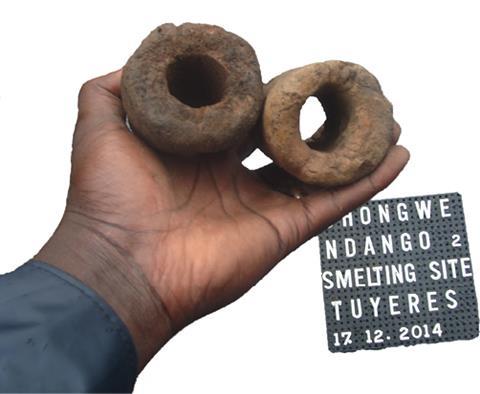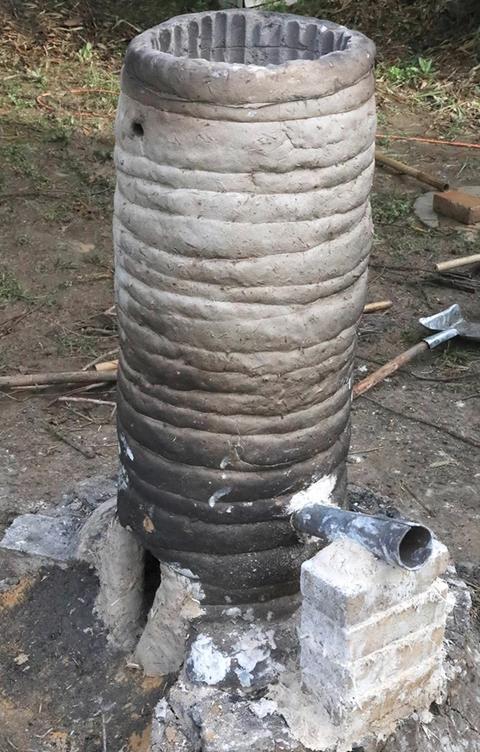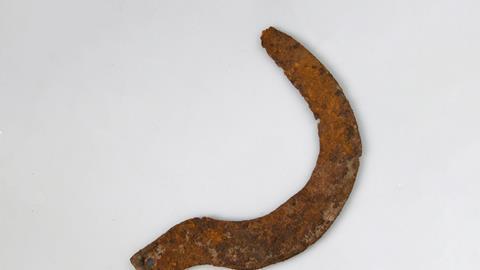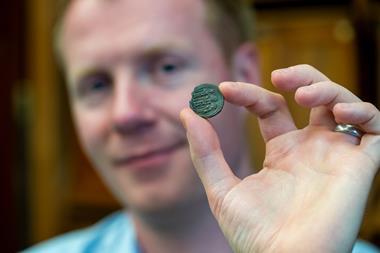The fires of traditional African iron smelters burned out a century ago and now the researchers dedicated to uncovering their stories are disappearing from the continent too, writes Hayley Bennett
For more than a decade, Tanzanian archaeologist Edwinus Lyaya has been searching for traces of an African technology – and tradition – that he worries is ‘disappearing without notice’. In his home country and neighbouring Zambia, in the Great Lakes region of eastern Africa, he has often focused his search on the western side of termite mounds. Here, the fat chimneys of iron-smelting furnaces (malungu) once stood up to three metres tall, their walls likely moulded from the termite mound clay itself. In Zambia, Lyaya exposed the bases of three or four per mound, their chimneys now toppled.
These traditional charcoal-fuelled furnaces reached temperatures well over 1000°C and were attended to by smelters who were skilled in feeding the flames and ‘delivering’ the iron ‘bloom’ from the belly of the furnace in a process tied to ritual and representations of childbirth. They are just one example of an extraordinary array of different iron technologies used by Africans for millennia to produce tools for farming and weapons of war, alongside all manner of decorative objects.
Lyaya is an archaeometallurgist at the University of Dar es Salaam. He specialises in analysing the remains of old iron-working sites: pieces of iron bloom, burned charcoals, solidified slag (a waste material) and tuyères (pipes) for firing the furnace or tapping out slag. Due to funding issues and a lack of facilities for scientific analysis, his is a rare breed in Africa – Zambia, for instance, doesn’t have an archaeometallurgist to call its own. ‘It’s very difficult to practice archaeometallurgy in Africa, because of the lack of instruments and equipment,’ he says. ‘So you have to really forge your own way forward.’ That’s what Lyaya has done, completing his doctorate in the UK and then securing funding from the Volkswagen Foundation in Germany so he could take the samples collected during his postdoctoral studies to Africa’s only archaeological materials lab at the University of Cape Town in South Africa.
A rich tradition
This lack of facilities is not matched by any lack of archaeological finds. Across Africa, archaeologists – though often from US and European institutions – have uncovered evidence for a more diverse history of ironworking than on perhaps any other continent. Its rich tradition in iron was recently alluded to in a widely reported study – now under fire – suggesting that 18th century British ironworking innovations were taken from fugitives of the slave trade working in Jamaica. In fact, while Lyaya’s tall termite mound furnaces are relatively recent, dating back to the 17th century, fierce debate has raged since the 1950s over whether iron metallurgy in sub-Saharan African emerged before the first millennium BCE and if it was independently invented or imported from elsewhere via North Africa. But the science of archaeometallurgy exists not just to answer questions of when, but how and to what end: how did Africans produce iron and what kinds did they produce?

The problem for African archaeologists is a lack of resources for them to take charge of the research themselves. David Killick, an anthropologist at the University of Arizona in the US who spent many years working on African iron projects, says he has seen the frustration of African researchers trained in the west who are unable to use the techniques they have learned, including chemical analysis techniques, in their own countries. ‘Many African countries can barely afford archaeology at all,’ he says. ‘These expensive modern analytical techniques are just a dream.’
In many ways, Lyaya’s situation typifies that of African archaeological scientists, a situation he lamented in a paper published last year. But despite these limitations, he remains motivated by a desire to put the rest of the world straight on the details of how African iron (and steel) were made – his careful examination of ironworking remains from the Great Lakes region hints at intricacies in traditional ironworking processes that may have been overlooked more widely. As Lyaya tells Chemistry World from his home village in Tanzania, this kind of work starts far from the lab. ‘Before lab work, you need field work,’ he says. In the case of his doctoral thesis in Tanzania, the fieldwork involved archaeological surveys in multiple villages, speaking to locals and enlisting help from students to carry out walking surveys, during which they looked for broken tuyères, pieces of furnace wall, slag and ore to track down iron-working sites. Of 121 separate sites initially identified, Lyaya eventually excavated four to yield the samples he would take to the lab.
Blast from the past
The ‘bloomery‘ iron smelting process shares similar chemistry with blast furnaces, in a simplistic sense, in that it also relies on carbon monoxide and heat to drive reduction reactions that produce iron from the iron oxide in iron ore. The technologies are different, however. Blast furnaces get hot enough to produce liquid metal that can be collected continuously; early European examples were fired by forceful ‘blasts’ of air delivered by water wheel-powered bellows. Bloomeries, by contrast, operated below the melting point of iron to yield a solid, spongey mass called bloom that was removed when the smelt ended. Air was driven in through tuyères or vents via hand-operated bellows, or drawn in by convection, as seems to have been the case with Lyaya’s tall ‘natural draft’ furnaces. They burned charcoal, instead of coke, to generate carbon monoxide.
There are furnaces of every size from tiny to massive
When it comes to the details of how African ironworkers extracted iron from iron ore, however, it’s hard to generalise, not least because of the staggering diversity of different technologies. ‘There are furnaces of every size from tiny to massive,’ says Jake Keen, an independent smelter and researcher based in Dorset, UK, who has observed and reproduced traditional iron smelting techniques as part of research projects all over the world, including in Africa. ‘The furnaces are blown by all manner of bellows and by natural draft. The air enters by tuyères of many types and sizes and number.’ Within sub-Saharan Africa, archaeometallurgy has led to the discovery of numerous examples of iron smelting processes never seen elsewhere, including Nigerian furnaces for smelting titanium-rich ores that blast furnaces could not handle.
European histories view bloomery furnaces as what came before blast furnaces, because it is blast furnaces that are considered to have facilitated the expansion of the iron industry that led to the Industrial Revolution. But in Africa, the blast furnace and other systems for making iron and steel weren’t needed or wanted. ‘[T]here existed deep-seated cultural barriers that may have prevented the assimilation of exotic technologies,’ archaeometallurgist Shadreck Chirikure wrote in his 2015 book, adding that as Africa’s existing technologies worked – producing iron of sufficient quantity and quality – there was ‘no need to change them [for] alien ones’. Thus, the last embers of bloomery furnaces didn’t die out until the 20th century, by which time the slave trade had stripped out much of the continent’s ironworking skill.
Charged debate
The question still troubling some archaeologists, though, is how Africans learned to use this technology in the first place. One long-standing argument for it being imported from elsewhere is that, in Africa, iron metallurgy seemed to come before copper metallurgy, unlike everywhere else, where it was the other way around. As Augustin Holl, an African archaeologist at Xiamen University in China, explains, those who take a ‘gradualist’ perspective believe that high-temperature iron metallurgy could only have developed step by step from lower temperature technologies based on copper, as it did in Europe. By his way of thinking, though, there’s no reason Africans couldn’t have taken one much larger step straight to making iron. ‘Let’s call it punctuated equilibrium,’ he says. ‘Meaning you have jumps in the evolution of human social systems and even technologies… You have discoveries, serendipities and then clever people take advantage of that to do something that was unknown before.’

Meanwhile, heated debate still surrounds radiocarbon dates produced for charcoal from African ironworking sites that would make these sites some of the world’s oldest. They include dates from Holl and colleague Etienne Zangato in Cameroon and Central Africa , as well as from archaeologists working in the Nsukka region of Nigeria, and suggest origins for traditional African metallurgy in the second millennium BCE or earlier. Holl’s dates have been dismissed by some (including Killick) who argue that they came from wood from very old trees used to make the charcoal or from mixing between layers of earth due to the digging of pits. They put the origins of African metallurgy closer to the early first millennium BCE, but of course, with relatively few sites across this vast continent investigated so far, the possibility for earlier origins remains open. The debate is, understandably, charged because of what independent mastery of iron technology represents for African heritage and identity: a marker of civilisation and recognition that Africa is not, as it has often been cast, a ‘mere recipient’ of such knowledge. For his part, Holl knows he will need to bring ‘a bundle of evidence’ to convince his detractors and is currently making plans to collect new evidence from one of the controversial sites in Cameroon.
Whatever the chronology, it’s clear that this older way of making iron took off well before the birth of chemistry, making it hard to envisage how smelters controlled the complex reactions involved. It is likely through careful adherence to ritual, Keen says, that smelters made sure they got the results they desired, with these rituals extending to everything from the siting and construction of the furnaces to blood sacrifices made in their honour. Mostly, smelting took place in what Keen calls a ‘clay tube’, providing precious insight as to what was going on inside. As Keen has surmised through 40 years of smelting and over 280 smelts, it’s only what’s going into the tube (ore, charcoal and air) and what’s coming out at the bottom (slag) that can provide any visible indication of the smelt’s progress. Therefore, the look and viscosity of the molten slag, a mixture of iron oxide, silicon dioxide and smaller quantities of mostly metals and metal oxides, is vitally important, hinting at how much iron it contains. In some African furnaces, slag was ‘tapped’ out of the furnace while in others it ran into a pit below.
All that remains
In the present day, solidified slag remnants, while greyish and unassuming, can provide powerful testament to past ironworking. In principle, experimental smelting approaches could be used to reverse engineer smelting processes – to try to recreate the conditions that produced slag with a particular look and chemistry. This approach may not provide direct evidence of past smelting techniques, but it does demonstrate the connection between the process itself and what remains of it.
For example, in a 2022 study, Keen collaborated with Russian and Israeli researchers to smelt iron ore from southern Israel, helping to show that the decisions the smelter makes, including the rate at which they ‘charge’ the furnace with charcoal and the ratio of ore to charcoal they use, are reflected in the chemical composition of the slag. Using x-ray fluorescence (XRF) – one of the chemical analysis methods most beloved by archaeologists – the researchers also tracked the chemical profile of slag over the course of a smelt, showing that it becomes richer in iron while decreasing in silicon, calcium and aluminium. The takeaway is that the slag from an old smelting site can be used to build a picture of the kinds of technique smelters used there, but only when more than a few fragments survive to represent different stages in the process.
Slag analysis forms an important part of Lyaya’s work too. Since his doctorate, he has been focused on trying to use slag to identify what he terms iron ‘refining’ sites in the Great Lakes region – sites where he argues already-smelted iron bloom was reheated in separate furnaces (vintengwe) under highly reducing conditions to increase its carbon content, forming steel. Why? Accounts from locals suggest it would have used up too much charcoal to make steel in the tall malungu smelting furnaces. Lyaya’s work in Mbozi and Sumbawanga in Tanzania shows the vintengwe furnaces were different: smaller and driven by bellows rather than the natural draft mechanism. It also suggests these refining furnaces can be identified by the slag they produced, which differed in both appearance and contents. Refining, however, isn’t included in the ‘two-step’ process usually used to describe bloomery processes, which consists of smelting followed by smithing to forge metal objects. According to Lyaya, ‘The problem is … whoever has been coming to Africa has been coming with – in their heads – the two stages which are globally known… They’re blindfolded to refining.’ So, he says, he wants to ‘show the world’ this other dimension to ironworking in the Great Lakes region.
As he explains, a great deal of detective work can be done in the field. The slag heaps from vintengwe are smaller and the slag material itself is smooth compared to the mixture of textures seen from smelting furnaces. But closer inspection reveals another key difference: refining slags contain tiny, roundish metal droplets that he says aren’t seen in the smelting slags. Spot analysis of the droplets with a small x-ray probe showed Tanzanian refining slags contained between 0.2–5.5% carbon, suggesting they were associated with an end-product that was not soft iron, but steel. ‘This is not surprising because we have some examples of technologies in Africa that have produced carbon-rich products,’ Lyaya says. ‘But it’s very possible that we have been confusing between smelting and refining plants – we’ve been analysing them thinking they are smelting, but actually they are refining.’
Scientific collaborations between Africans and non-Africans can be very tricky
Unfortunately, when Lyaya took this same theory with him in his search for Zambian furnaces, he wasn’t able to firmly identify any vintengwe – most furnaces were instead the taller malungu type. But he now hopes to take his search to Malawi, where Killick previously found evidence for refining. According to Killick, though, Lyaya will have to do more to convince him that the refining furnaces were for making steel. ‘The blooms produced in tall natural draft furnaces were typically already steel,’ he says, referring to furnaces in the West African Sahel and the Southeast African savannas. ‘So I don’t think that [Lyaya] is correct about the refining furnaces being used to carburise iron to steel.’ For him, Lyaya needs to prove beyond doubt that the steel droplets are present in the refining slags but not in the smelting ones. Still, he agrees that refining should be considered part of the overall chain of operation, describing it as a process for compacting the bloom and squeezing out the slag.
Lyaya admits that he needs to do more to confirm in the lab what he feels is very clear in the field; a tough prospect given the current lack of resources and facilities for African archaeometallurgy. He also needs funding for further radiocarbon dating, the price of which often exceeds £300 per sample, to establish how far the ironworking technologies in the region go back and where they originated. As it is though, there is only one radiocarbon lab south of the Sahara and it’s currently ‘crippled’ by daily power cuts, according to Killick, so African archaeologists are forming partnerships with European countries to get their dates.
More generally, dependence on western institutions and researchers for access to facilities presents a problem, and means that samples collected during fieldwork end up in a backlog. ‘We do not control the infrastructure,’ says Holl. ‘And [this] makes scientific collaborations between Africans and non-Africans, particularly westerners, very tricky, because it is a relationship of domination that is generally involved.’ This is a sad situation, given that unless Africans researchers can find a way to carry on their work, the science of archaeometallurgy may disappear from Africa just as the tradition of African iron smelting did, leaving very many stories untold.
Hayley Bennett is a science writer based in Bristol, UK


















No comments yet